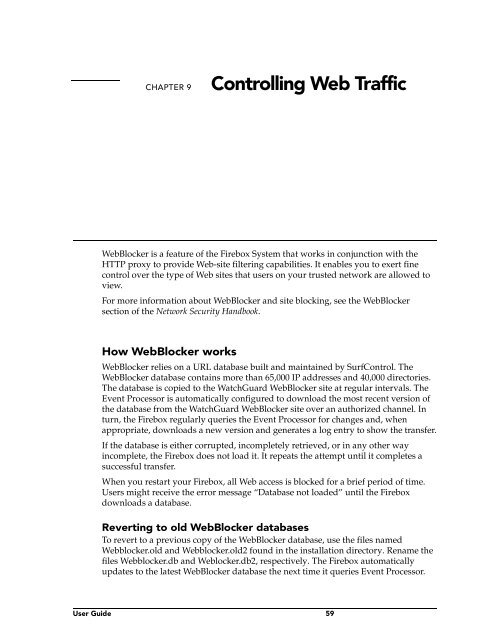WatchGuard Firebox System 4.6 User Guide
WatchGuard Firebox System 4.6 User Guide WatchGuard Firebox System 4.6 User Guide
Service precedence58
CHAPTER 9Controlling Web TrafficWebBlocker is a feature of the Firebox System that works in conjunction with theHTTP proxy to provide Web-site filtering capabilities. It enables you to exert finecontrol over the type of Web sites that users on your trusted network are allowed toview.For more information about WebBlocker and site blocking, see the WebBlockersection of the Network Security Handbook.How WebBlocker worksWebBlocker relies on a URL database built and maintained by SurfControl. TheWebBlocker database contains more than 65,000 IP addresses and 40,000 directories.The database is copied to the WatchGuard WebBlocker site at regular intervals. TheEvent Processor is automatically configured to download the most recent version ofthe database from the WatchGuard WebBlocker site over an authorized channel. Inturn, the Firebox regularly queries the Event Processor for changes and, whenappropriate, downloads a new version and generates a log entry to show the transfer.If the database is either corrupted, incompletely retrieved, or in any other wayincomplete, the Firebox does not load it. It repeats the attempt until it completes asuccessful transfer.When you restart your Firebox, all Web access is blocked for a brief period of time.Users might receive the error message “Database not loaded” until the Fireboxdownloads a database.Reverting to old WebBlocker databasesTo revert to a previous copy of the WebBlocker database, use the files namedWebblocker.old and Webblocker.old2 found in the installation directory. Rename thefiles Webblocker.db and Weblocker.db2, respectively. The Firebox automaticallyupdates to the latest WebBlocker database the next time it queries Event Processor.User Guide 59
- Page 17 and 18: CHAPTER 1LiveSecurity ServiceNo Int
- Page 19 and 20: LiveSecurity broadcasts• The Lice
- Page 21 and 22: CHAPTER 2Technical SupportDevelopin
- Page 23 and 24: TrainingAfter you enter your LiveSe
- Page 25 and 26: Online Help• On any platform, bro
- Page 27 and 28: CHAPTER 3WatchGuard OptionsThe Watc
- Page 29 and 30: PART IIIConfiguring a SecurityPolic
- Page 31 and 32: CHAPTER 4Firebox BasicsThis chapter
- Page 33 and 34: Opening a configuration fileOpening
- Page 35 and 36: Setting the time zone• Use a comb
- Page 37 and 38: CHAPTER 5Using the WatchGuardContro
- Page 39 and 40: Control Center componentsThe first
- Page 41 and 42: Policy ManagerManipulating the Traf
- Page 43 and 44: Historical ReportsHistorical Report
- Page 45 and 46: CHAPTER 6Configuring a NetworkConfi
- Page 47 and 48: Setting up a routed network• All
- Page 49 and 50: Defining a host routeDefining a hos
- Page 51 and 52: Defining a Firebox as a DHCP server
- Page 53 and 54: CHAPTER 7Blocking Sites and PortsMa
- Page 55 and 56: Blocking a port permanently3 In the
- Page 57 and 58: CHAPTER 8Configuring ServicesThe Se
- Page 59 and 60: Defining service properties8 In the
- Page 61 and 62: Modifying a serviceThe following ex
- Page 63 and 64: Setting up proxy servicesSelecting
- Page 65 and 66: Setting up proxy servicesand transm
- Page 67: Service precedencecheck. In the lat
- Page 71 and 72: Configuring the WebBlocker serviceP
- Page 73 and 74: CHAPTER 10Setting Up NetworkAddress
- Page 75 and 76: Using service-based NATUsing servic
- Page 77 and 78: Configuring a service for incoming
- Page 79 and 80: CHAPTER 11Setting Up Logging andNot
- Page 81 and 82: Designating Event Processors for a
- Page 83 and 84: Setting up the LiveSecurity Event P
- Page 85 and 86: Setting global logging and notifica
- Page 87 and 88: Customizing logging and notificatio
- Page 89 and 90: CHAPTER 12Connect with Out-of-Band
- Page 91 and 92: Configuring the Firebox for OOB5 En
- Page 93: PART IVAdministering a SecurityPoli
- Page 96 and 97: Using host aliasesAdding a host ali
- Page 98 and 99: Configuring Firebox authenticationC
- Page 100 and 101: Configuring CRYPTOCard server authe
- Page 102 and 103: Using authentication to define remo
- Page 104 and 105: Firebox MonitorsSetting Firebox Mon
- Page 106 and 107: Firebox MonitorsLogging optionsLogg
- Page 108 and 109: HostWatchARP tableA snapshot of the
- Page 110 and 111: HostWatch6 To change playback prope
- Page 112 and 113: HostWatch102
- Page 114 and 115: Viewing files with LogViewer2 Confi
- Page 116 and 117: Working with log filesIP header len
CHAPTER 9Controlling Web TrafficWebBlocker is a feature of the <strong>Firebox</strong> <strong>System</strong> that works in conjunction with theHTTP proxy to provide Web-site filtering capabilities. It enables you to exert finecontrol over the type of Web sites that users on your trusted network are allowed toview.For more information about WebBlocker and site blocking, see the WebBlockersection of the Network Security Handbook.How WebBlocker worksWebBlocker relies on a URL database built and maintained by SurfControl. TheWebBlocker database contains more than 65,000 IP addresses and 40,000 directories.The database is copied to the <strong>WatchGuard</strong> WebBlocker site at regular intervals. TheEvent Processor is automatically configured to download the most recent version ofthe database from the <strong>WatchGuard</strong> WebBlocker site over an authorized channel. Inturn, the <strong>Firebox</strong> regularly queries the Event Processor for changes and, whenappropriate, downloads a new version and generates a log entry to show the transfer.If the database is either corrupted, incompletely retrieved, or in any other wayincomplete, the <strong>Firebox</strong> does not load it. It repeats the attempt until it completes asuccessful transfer.When you restart your <strong>Firebox</strong>, all Web access is blocked for a brief period of time.<strong>User</strong>s might receive the error message “Database not loaded” until the <strong>Firebox</strong>downloads a database.Reverting to old WebBlocker databasesTo revert to a previous copy of the WebBlocker database, use the files namedWebblocker.old and Webblocker.old2 found in the installation directory. Rename thefiles Webblocker.db and Weblocker.db2, respectively. The <strong>Firebox</strong> automaticallyupdates to the latest WebBlocker database the next time it queries Event Processor.<strong>User</strong> <strong>Guide</strong> 59



